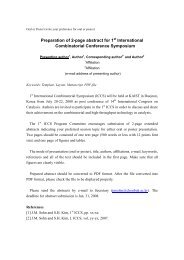Bidding - the International Association of the Catalysis Societies
Bidding - the International Association of the Catalysis Societies
Bidding - the International Association of the Catalysis Societies
You also want an ePaper? Increase the reach of your titles
YUMPU automatically turns print PDFs into web optimized ePapers that Google loves.
C&EN Volume 77, Number 26, p. 10-11 (June 28, 1999)<br />
Photocatalysts split water in high yield<br />
The prospect <strong>of</strong> using solar energy to convert water into hydrogen and oxygen has received a boost with<br />
<strong>the</strong> discovery <strong>of</strong> a new class <strong>of</strong> semiconducting photocatalysts that are highly efficient at splitting water<br />
under ultraviolet irradiation.<br />
The new photocatalysts were prepared from materials known as layered perovskites by chemical<br />
engineering pr<strong>of</strong>essor Jae S. Lee and coworkers at Pohang University <strong>of</strong> Science & Technology, South<br />
Korea [Chem. Commun.,1999, 1077].<br />
The group showed that by impregnating <strong>the</strong> layered perovskite powders with nickel, quantum yields <strong>of</strong><br />
up to 23% can be achieved. The quantum yield is <strong>the</strong> percentage <strong>of</strong> photons used to generate products in a<br />
photochemical reaction. The previous best quantum yield for UV-photocatalytic water splitting, 5%, was<br />
achieved by chemistry pr<strong>of</strong>essor Kazunari Domen and his group at Tokyo Institute <strong>of</strong> Technology using<br />
o<strong>the</strong>r types <strong>of</strong> layered perovskites.<br />
"Our work has achieved not only unprecedented high quantum yields but also demonstrates a strong<br />
relationship between structure and performance <strong>of</strong> <strong>the</strong> semiconductor photocatalysts," Lee tells C&EN.<br />
The perovskite materials prepared by <strong>the</strong> Korean group have <strong>the</strong> generic composition A m B m O 3m+2 , where<br />
A is Ca, Sr, or La; B is Nb or Ti; and m is 4 or 5. The group showed that <strong>the</strong> highest rates <strong>of</strong> water<br />
splitting occur when <strong>the</strong> materials are loaded with 1.0% by weight <strong>of</strong> nickel.<br />
"The discovery that this class <strong>of</strong> compounds makes good UV-photocatalysts is important," comments<br />
Thomas E. Mallouk, chemistry pr<strong>of</strong>essor at Pennsylvania State University, University Park. "To go from<br />
5% to 23% quantum efficiency for overall water splitting is a big step. However, <strong>the</strong> process requires UV<br />
light. To be useful, a catalyst would need to work with visible light."<br />
In general, photocatalytic water splitting over a semiconductor occurs when <strong>the</strong> catalyst is illuminated<br />
with light <strong>of</strong> sufficient energy to generate excited electron-hole pairs that can be separated. It is not yet<br />
clear, Mallouk points out, how <strong>the</strong>se new materials work or what <strong>the</strong>ir microstructures are.<br />
"If we can understand <strong>the</strong> mechanism <strong>of</strong> photochemical charge separation in this new class <strong>of</strong> compounds,<br />
<strong>the</strong>n it may help us to improve on existing materials which operate, albeit inefficiently, with visible light,"<br />
Mallouk says.<br />
Lee's group is already looking at ways to modify <strong>the</strong>se materials for use with visible light. "We are<br />
working on new preparation methods to increase <strong>the</strong>ir surface areas," he says. "With high surface areas,<br />
such materials might find applications not only in photocatalytic water splitting but also in <strong>the</strong><br />
photodestruction <strong>of</strong> toxic materials and in <strong>the</strong> reduction <strong>of</strong> carbon dioxide."<br />
- 78 -



